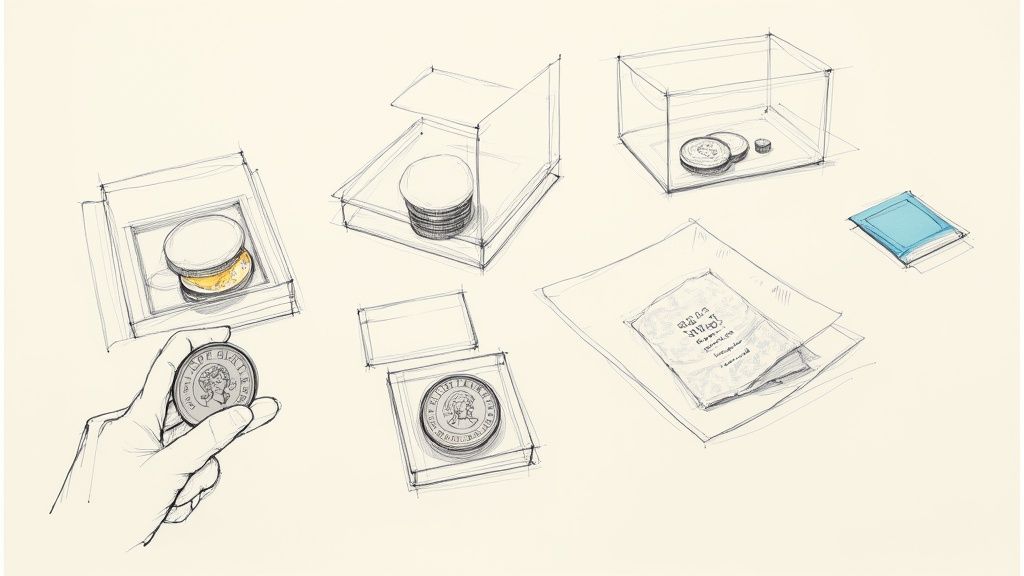Proper storage of coins isn't just a fussy detail for serious collectors; it's a fundamental part of protecting their value, history, and raw beauty from the quiet damage of time and environment. This is about more than just organisation. It’s about creating a safe haven for your investment using archival-quality materials to fend off corrosion, ugly toning, and physical wear.
Why Smart Coin Storage Matters
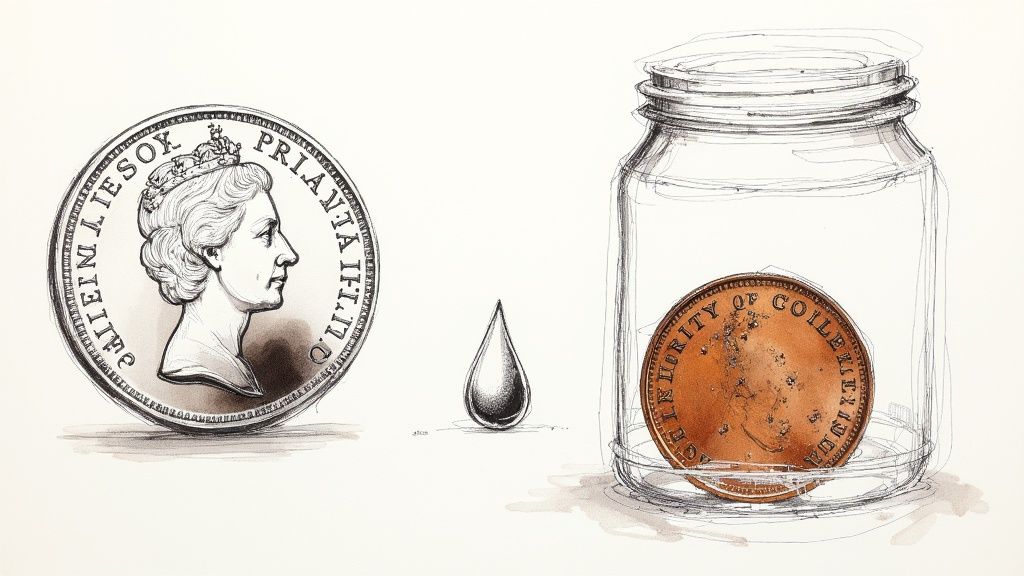
Before you even think about buying a single album or holder, it’s vital to grasp why this is all so critical. A coin collection is so much more than a hobby. It's tangible history you can hold, and often, a significant financial asset. The trouble is, coins are surprisingly delicate and susceptible to their surroundings. The real dangers are often invisible, causing irreversible harm before you even spot a problem.
Think about leaving a brilliant, uncirculated silver Britannia in a standard wooden drawer. Within just a few months, airborne sulphur—something that’s present in most homes from paint, paper, and textiles—can react with the silver. The result is an ugly, dark toning that can slash its numismatic value. This isn't the attractive, desirable patina some collectors appreciate; it's uncontrolled chemical damage.
The Dangers of an Uncontrolled Environment
Humidity is another huge threat, especially in the typical British home where damp can creep in. High humidity speeds up oxidation, which leads to corrosion on reactive metals like copper and bronze. A beautiful Victorian penny, with all its intricate detail, can quickly develop dark spots or even that dreaded green patina if it's left in a damp loft or basement.
Protecting a coin means creating a stable micro-climate for it. The main goal is to shield it from three key threats: chemical reactions from the air and unsafe materials, physical damage from knocks and drops, and environmental instability like fluctuating heat and humidity.
Even storage methods that seem harmless can be destructive. Simply tossing coins into a jar or a basic box means they're constantly rubbing against each other. The delicate details on a coin’s surface—the monarch's portrait, the fine lettering—get worn away. This type of abrasion, known in the hobby as "bag marks," can seriously lower a coin's grade and its appeal to other collectors.
Understanding Different Metal Reactions
There's no single "best" way to store coins, because different metals react to the environment in very different ways.
- Silver: Very reactive to sulphur compounds in the air, which leads to toning or tarnish. It's also vulnerable to damage from chlorides, often found in cheap PVC plastics.
- Copper: Extremely prone to oxidation. When exposed to moisture and air, it can develop anything from a dark brown patina to destructive green corrosion.
- Gold: As a noble metal, gold is incredibly resistant to corrosion and oxidation. The main risk here is physical damage. Gold is a soft metal, so scratches and dents are the primary concern.
- Cupro-Nickel: Most of our modern coins are made of cupro-nickel, which is quite durable. Still, even these can tarnish or develop spots when exposed to moisture and pollutants over a long time.
Ultimately, smart storage is an act of preservation. It’s how you ensure the story, craftsmanship, and value of every piece you've acquired are safeguarded for the future. It's not about creating chores, but about showing respect for the history you've worked so hard to collect.
Choosing the Right Storage Materials
The long-term health and value of your collection come down to the materials you choose for the storage of coins. Picking the right holders, albums, and envelopes isn't just about keeping things tidy; it's your primary defence against chemical damage that can permanently ruin your prized pieces. If you get this right, you’ve already won half the battle.
Making the right choice means getting to know a few key materials. Some are heroes in the numismatic world, while others are absolute villains. For any serious collector, understanding the difference is non-negotiable.
The Gold Standard: Archival-Safe Plastics
When you're after the best protection money can buy, your search should begin and end with inert, archival-grade plastics. Museum curators and professional numismatists trust these materials for a very simple reason: they don't react with or degrade the coins they are supposed to protect.
Two names, in particular, stand out from the crowd:
- Mylar (Polyester): Often seen as the peak of archival safety, Mylar is a tough, clear, and chemically stable plastic. It creates a brilliant barrier against moisture and atmospheric gases, essentially sealing the coin in its own little protective bubble.
- Polyethylene: This is a slightly softer and more flexible plastic that is also completely inert and safe for long-term coin contact. It's frequently used for bags or sleeves when storing coins in bulk and is a dependable, cost-effective option.
Think of these materials as your collection's best friends. When you see products from reputable UK brands specifying they're made from Mylar or are "archival-safe," you can buy them with complete peace of mind.
The Collector's Nemesis: PVC
Now, let's talk about the most infamous material in coin collecting: PVC (polyvinyl chloride). You'll often find this soft, flexible plastic in older, cheaper coin albums and flips. It might look harmless, but it's a ticking time bomb for your collection. Over time, PVC breaks down and leaches plasticisers—oily, acidic chemicals that create a sticky, greenish film on your coins' surfaces.
This green slime isn't just ugly; it actively corrodes the metal underneath, causing permanent pitting and damage that can completely obliterate a coin's value. In most cases, the damage is irreversible.
How to Spot PVC: The easiest giveaway is the smell—it's often compared to a new shower curtain. PVC also feels very soft and pliable, unlike the crisp, more rigid feel of Mylar. If you have any older albums and you're not sure, the safest bet is to assume they contain PVC and move your coins to a modern, inert holder immediately.
This infographic clearly shows the chemical risk posed by common storage materials, driving home just how dangerous PVC is.
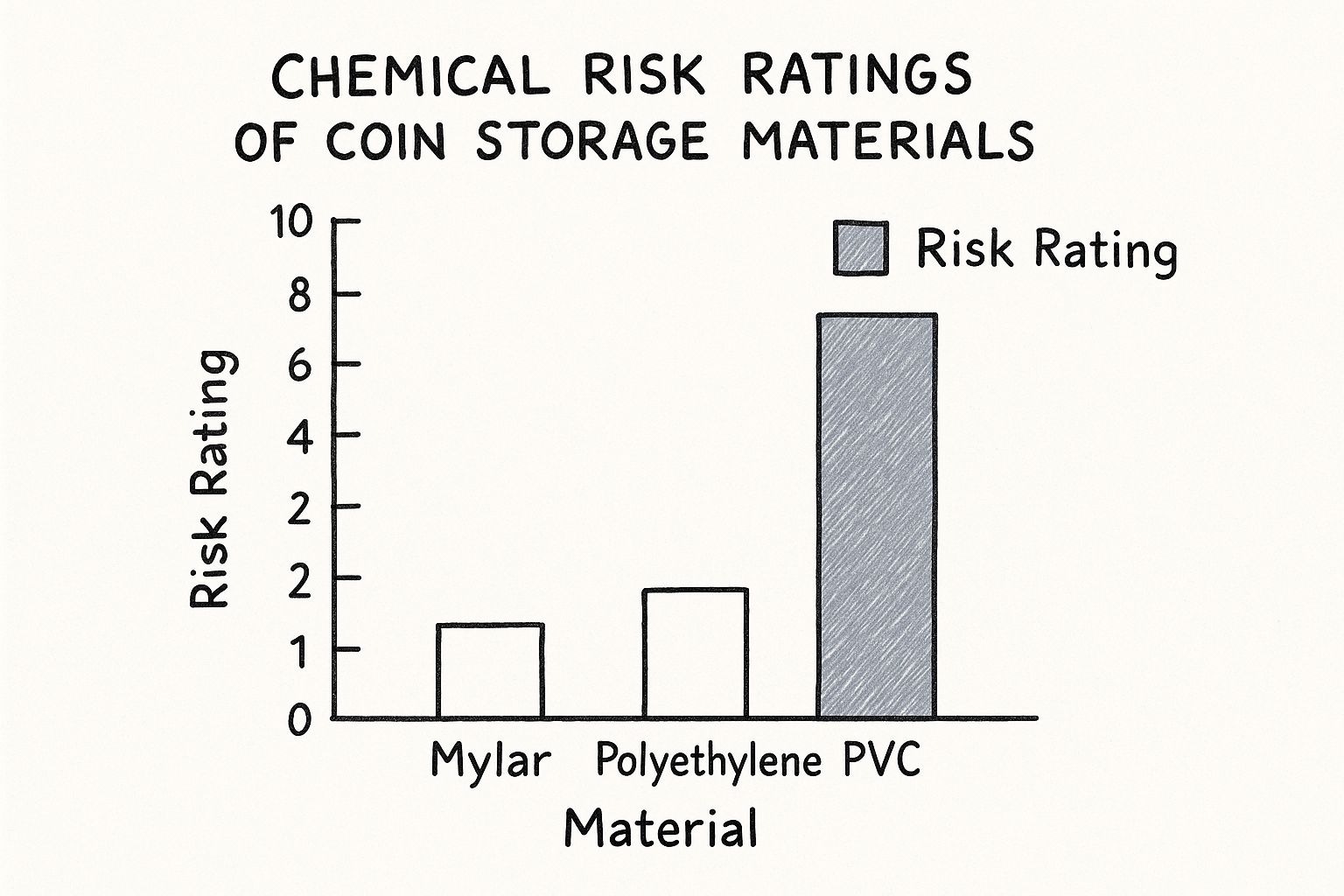
As the chart shows, while archival materials like Mylar are incredibly low-risk, PVC presents a severe and direct chemical threat to your collection.
Paper Envelopes: A Word of Caution
Paper can be a perfectly fine storage solution, but only if you use the right kind. Don't just grab a standard office envelope or a scrap of writing paper. These contain acids and sulphur from the manufacturing process that will, over years of contact, cause nasty toning and even corrosion, especially on silver and copper coins.
Always seek out envelopes sold specifically for coin storage that are clearly labelled "acid-free" or "archival quality." These are made from pure materials that won't harm your coins.
By investing in quality, inert materials from the very beginning, you are making the single most important decision to safeguard your collection for the future.
Your Guide to Coin Holders and Albums
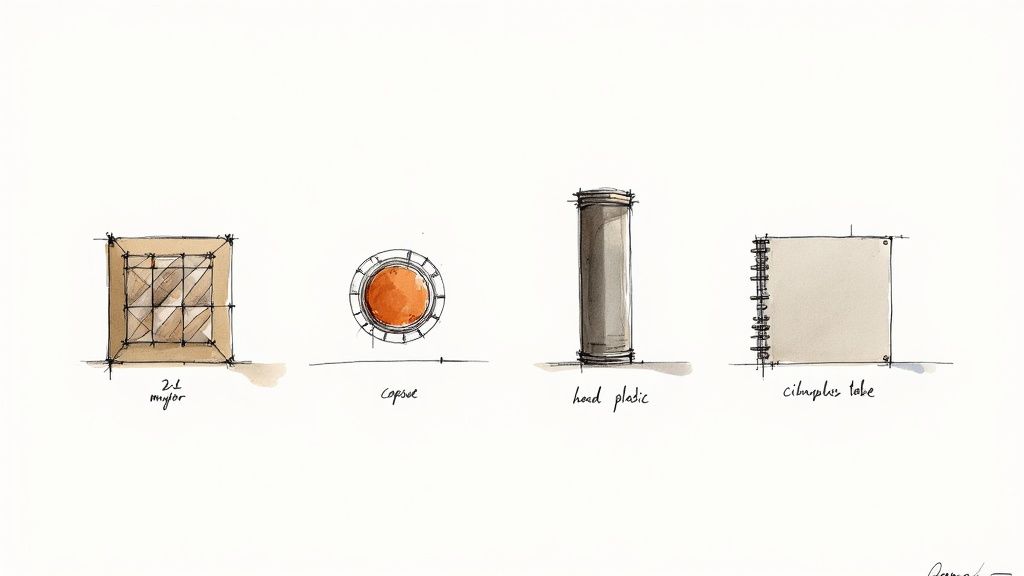
Once you’ve got your head around the right materials, the next big decision is choosing the specific products to house your collection. There’s a huge market out there, with options for everything from a single treasured piece to a sprawling set of modern 50ps.
The choice you make comes down to a balance of protection, visibility, cost, and how you want to organise everything. Each method has its own pros and cons, and what works for one collector might not suit another. Let's break down the most popular options available here in the UK to help you find the perfect fit.
The Workhorse: 2x2 Cardboard Flips
For many of us, the 2x2 cardboard flip is the first and most versatile tool we ever use. These are simple, foldable cardboard squares with a clear window in the middle. You pop the coin in, fold it over, and staple it shut. Simple as that.
They are incredibly popular for good reason. They’re cheap, making them brilliant for organising large collections of low to mid-value coins without breaking the bank. The cardboard frame also gives you plenty of space to jot down key details like the year, denomination, and grade.
But there’s a catch. It is absolutely critical that you buy flips with Mylar windows. Cheaper ones might use soft plastics containing PVC, which, as we know, will ruin your coins over time. Also, be careful with the staples – a misplaced one can easily scratch an adjacent coin when they’re all packed in a storage box together.
Maximum Security: Hard Plastic Capsules
Got a high-value coin? Maybe a rare proof set, a gold sovereign, or a perfectly preserved silver crown? That’s where hard plastic capsules are the undisputed champs. These are two-piece, interlocking containers, often made from acrylic, that are sized to hold a specific coin snugly, stopping it from rattling around.
Capsules offer some serious benefits:
- Superior Physical Protection: They’re highly resistant to drops, knocks, and scratches. Think of them as a little suit of armour for your coin.
- Excellent Visibility: The crystal-clear plastic gives you an amazing, unobstructed view of both sides of the coin.
- Airtight Seal: Many of the premium capsules create a nearly airtight environment, which is fantastic for protecting against atmospheric nasties.
The trade-off? Cost and space. Capsules are a lot more expensive per coin than cardboard flips and take up much more room. They're best reserved for your absolute favourite or most valuable pieces.
Bulk Storage: Coin Tubes
What do you do when you have dozens, or even hundreds, of the same coin? Maybe you’ve bought silver Britannias in bulk or have a huge jar of old pennies. Storing them one by one just isn't practical. This is where plastic coin tubes are a lifesaver.
These are simple, cylindrical tubes with screw-on caps, designed to hold a roll of a specific coin. They’re space-efficient, sturdy, and do a good job protecting bulk coins from rattling against each other and from the environment. Just make sure you opt for tubes made from inert plastics like polyethylene to keep them safe long-term.
The passion for coin collecting in the UK is as strong as ever. A survey by The Royal Mint found that coins are the second most popular collectible item, with over a third of people expressing an interest. While the average collector spends around £1,500, a dedicated 3.5% spend over £10,000, showing just how deep the hobby runs. You can dive into the full report from The Royal Mint to learn more.
The Classic Appeal: Coin Albums
For anyone who loves seeing their collection as a curated set, you can't beat a classic coin album. These binders have pages with perfectly sized slots for specific coin series—think of completing a set of every monarch's portrait on the 50p or a full date run of Victorian pennies. They offer a wonderfully organised and visual way to track your progress.
When you're choosing an album, safety is everything. Modern, reputable brands use inert materials, but older, second-hand albums can be a minefield of PVC. If you inherit or buy an old album, give the pages a feel. If they’re soft, flexible, and have that distinct "shower curtain" smell, steer clear. For some great modern options, you might want to check out our guide to the top coin collecting albums for 2025.
Making the Right Choice: A Comparison
To help simplify your decision, we've put together a quick comparison of the most common storage methods. Looking at them side-by-side can make it much clearer which option is right for different parts of your collection.
Comparing Popular Coin Storage Methods
| Storage Method | Level of Protection | Best For | Visibility | Cost per Coin |
|---|---|---|---|---|
| Cardboard Flips | Moderate | Organising large, varied collections | Good (both sides) | Low |
| Hard Capsules | Very High | High-value, proof, or rare coins | Excellent | High |
| Plastic Tubes | Good (Bulk) | Storing multiple identical coins | Poor (only edges) | Very Low |
| Coin Albums | Good | Completing and displaying sets | Good (one side) | Moderate |
In the end, most collectors I know use a mix of these methods. Your circulated pennies might go into tubes, your main collection into 2x2 flips organised in storage boxes, and your real treasures get pride of place in individual hard plastic capsules. The key is to match the storage method to the coin's value and your personal collecting goals. That way, you’ll create a system that's both secure and a joy to interact with.
Creating the Perfect Storage Environment
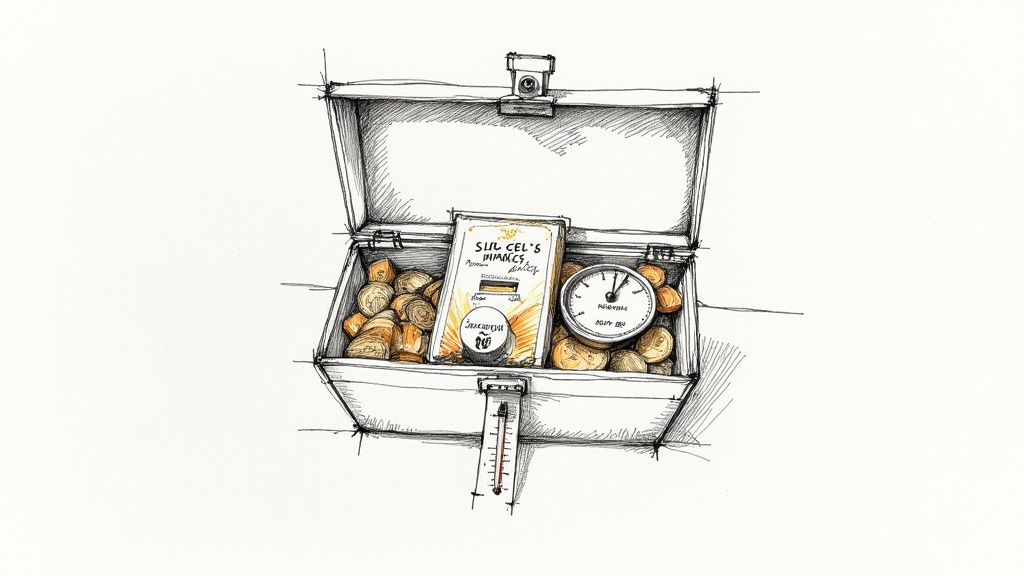
Choosing the right holders and albums for your coins is a fantastic start, but that individual protection is really only half the battle. The broader environment where you actually keep your collection is just as crucial for long-term preservation. A coin sitting pretty in a top-quality Mylar flip is still at risk if it’s stored somewhere damp and drafty.
Think of it this way: the holder is your coin's clothing, but the storage location is its home. If that home has a leaky roof and no central heating, even the best coat won't protect it forever. Creating a stable micro-climate should be your ultimate goal, and luckily, it’s much easier than it sounds.
Taming Temperature and Humidity
The two greatest environmental enemies of any coin collection are extreme temperature swings and high humidity. These factors are notorious for accelerating chemical reactions like oxidation and toning, and can even encourage mould to grow on albums and paper envelopes.
For most collections, the sweet spot is a stable temperature and a relative humidity level that stays consistently below 50%. Now, keeping a large room at this level might be a bit much, but you can easily control the conditions inside a smaller, enclosed space. This is where you create your own 'micro-climate'.
A stable environment is far more important than a specific temperature. Wild fluctuations from hot to cold cause the air to expand and contract, which can draw moisture into holders that aren't perfectly airtight, defeating their purpose.
For instance, a collector in Manchester could keep their main collection inside a large, archival-quality box. By popping a few silica gel desiccant packs inside the box with the coins, they can effectively lower and stabilise the humidity within that contained space, protecting the contents from the city’s famously damp air.
Choosing Your Storage Location Wisely
Where you physically put your collection in your home can make a massive difference. Some spots are just plain unsuitable for long-term coin storage and should be avoided at all costs.
- Attics: These are a terrible choice because of the extreme temperature swings, from freezing in winter to baking hot in summer.
- Basements and Cellars: While often cooler, they are frequently damp, making them a high-risk zone for humidity and mould.
- Garages and Sheds: Much like attics, these spaces are usually uninsulated and suffer from huge temperature and humidity fluctuations.
- Near Radiators or Windows: Direct sunlight and nearby heat sources will cause rapid temperature changes that put stress on both your coins and their holders.
The best location is usually a cupboard in a main living area or a home office. These spaces benefit from the house's general heating and insulation, providing a much more stable environment all year round. A sturdy safe is an excellent choice, as it offers security and a sealed environment you can easily manage with desiccants. To truly master environmental conditions, it's worth getting a better understanding temperature control systems and how they work.
Simple Tools for Climate Control
You don’t need to splash out on expensive equipment to manage your storage environment. A few simple, affordable tools can give you complete control over your collection’s micro-climate.
A small digital hygrometer, which measures humidity, is an essential and inexpensive bit of kit. Place one inside your main storage box or safe to keep an eye on conditions. If you see the humidity creeping above 50%, it’s time to add or refresh your desiccant.
Silica gel packs are your best friend here. You can buy them online very cheaply and they're incredibly effective. Even better, many types can be "recharged" by gently heating them in an oven, making them a sustainable and long-term solution. This simple but powerful combination of monitoring and control is the key to preservation. After all, with the UK having approximately 27 billion coins in circulation, ensuring your own collection is properly preserved is a worthy goal.
How to Catalogue Your Coin Collection
Great coin storage is about more than just physical protection; it’s about organisation. A well-documented collection is infinitely easier to manage, enjoy, and value with any accuracy. Without a solid inventory, you risk buying duplicates, forgetting where a coin came from, or being unable to properly insure your collection.
Creating an inventory isn't just some chore you do for the insurance company. It actually transforms your relationship with your collection. It’s how you spot the gaps in a series you're building, keep an eye on your spending, and get that satisfying feeling of seeing how much your collection has grown. It's the story of your hobby, written down.
What Information to Record
To build a catalogue that’s genuinely useful, you need to be consistent. Recording the same set of details for every single coin will save you from massive headaches down the road. The goal is to capture the essential details that tell each coin’s unique story.
Here are the key data points you should be tracking for every piece:
- Country of Origin: The nation that issued the coin (e.g., United Kingdom, Australia).
- Year: The date stamped right on the coin.
- Denomination: Its face value (e.g., Penny, Shilling, 50 Pence).
- Mint Mark: That tiny letter or symbol that tells you where it was struck (like an 'S' for San Francisco on an American coin).
- Grade or Condition: Your best honest assessment of its condition (e.g., VF for Very Fine, UNC for Uncirculated). The key is to be consistent with your grading.
- Purchase Details: Jot down when you bought it, who from, and how much you paid.
- Storage Location: A quick note on where it is physically (e.g., "Album 3, Page 2" or "Capsule Box A").
That last point about location is surprisingly critical. Once a collection starts to grow, it's shockingly easy to forget where you put one specific coin. A quick reference in your catalogue saves a huge amount of frantic searching.
Choosing Your Cataloguing Tools
You’ve got a few options here, from simple pen and paper to dedicated software. Honestly, the best tool is the one you’ll actually use consistently. There’s no point splashing out on complex software if a straightforward spreadsheet does everything you need.
A basic spreadsheet program like Microsoft Excel or Google Sheets is a fantastic place to start. You can set up columns for all the data points mentioned above, and then easily sort, filter, and search your collection. You can even add a column for personal notes or a link to a photo of the coin.
For insurance purposes, a detailed inventory is the single most important document you can have. If you ever have to make a claim for theft or damage, a comprehensive, up-to-date list with photos and purchase prices is absolutely invaluable.
For those who prefer a bit more structure, dedicated coin collection management software is a great choice. Programs like CoinManage or Numista offer pre-built fields, huge databases to help you identify coins, and even tools for tracking market values. While some might have a subscription fee, they can offer a much richer experience for the serious collector. To dive deeper into this topic, you can find a wealth of information in our comprehensive guide on how to catalogue coins.
Adding Visuals to Your Records
A picture really is worth a thousand words, especially in numismatics. Taking clear photos of your most important coins adds a powerful visual element to your catalogue and serves as undeniable proof of ownership for insurance.
And you don't need a professional studio to do it. A modern smartphone camera is more than up to the task.
- Use a Plain Background: A solid white or black background really makes the coin pop.
- Ensure Good Lighting: You want soft, diffused light to avoid that harsh glare. Placing the coin near a window on a cloudy day often works wonders.
- Keep it Steady: Rest your phone on a book or use a small tripod to prevent blurry shots.
- Capture Both Sides: Always take clear photos of both the obverse (heads) and the reverse (tails).
Once you have your pictures, you can link them in your spreadsheet or upload them directly to your collection software. This one simple step elevates your catalogue from a plain list to a rich, visual archive of your numismatic journey.
Common Coin Storage Questions
When you're deep in the world of numismatics, you start to notice the same questions cropping up time and time again. Getting clear, reliable answers is absolutely crucial for protecting your collection and sidestepping common, often costly, mistakes. Let's tackle some of the queries we hear most often from fellow collectors.
Should I Clean Coins Before Storing Them
In almost every single case, the answer is a hard no. Cleaning your coins, especially with abrasive polishes or harsh chemicals, is one of the fastest ways to completely destroy their numismatic value. This kind of intervention causes microscopic scratches, known as hairlines, and strips away the natural patina that often makes a coin so desirable.
That subtle toning you see on an old silver crown? That's part of its history, and it's something many collectors actively seek out. If a coin is just covered in a bit of loose dust or dirt, the absolute most you should ever do is give it a gentle rinse in distilled water. After that, let it air dry completely on a soft, lint-free cloth—never, ever rub it dry. For anything more serious, your only safe bet is to consult a professional coin conservation service.
Never attempt to clean a coin yourself. The risk of causing irreversible damage is just too high. An uncleaned, original coin is almost always more valuable than one that's been improperly cleaned and damaged.
What Is the Correct Way to Handle My Coins
It’s not just a suggestion; it's a golden rule for any serious collector. The natural oils and acids on your skin can cause permanent damage, leaving behind fingerprints that can slowly corrode a coin's surface over time.
Always handle your coins by their edges, holding them carefully between your thumb and forefinger. The best practice is to wear soft, lint-free cotton or nitrile gloves, which provide an essential layer of protection. It’s also a smart habit to handle your collection over a soft surface, like a felt pad or a microfibre cloth. This can cushion the blow if you accidentally drop one.
How Do I Spot and Avoid PVC Damage
PVC, or polyvinyl chloride, is the absolute enemy of long-term coin storage. It was common in many older, cheap, and overly flexible coin holders, and it degrades over time. As it breaks down, it leaches acidic plasticisers, creating a sticky, greenish residue on the coin's surface.
This green film isn't just ugly; it actively eats away at the metal, causing permanent pitting and damage. You can often identify PVC by its distinct "new shower curtain" smell and its very soft, pliable texture. If you find a coin with this sticky green film, it's suffering from PVC damage. You need to carefully remove it from that holder immediately and transfer it to a modern, inert holder like a Mylar flip or a hard plastic capsule to prevent any more harm.
Finally, if you’re storing a large or valuable collection off-site, remember the container is only one piece of the puzzle. To truly safeguard your collection, it's worth getting familiar with general common storage unit mistakes that could jeopardise the condition or security of your coins.
At Cavalier Coins Ltd, we provide collectors with the high-quality, archival-safe storage solutions needed to protect every piece in their collection. Explore our range of supplies and rare coins at https://www.cavaliercoins.com.

